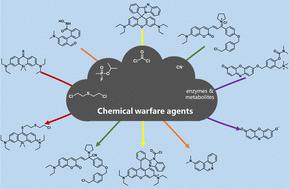当前位置:
X-MOL 学术
›
Chem. Soc. Rev.
›
论文详情
Our official English website, www.x-mol.net, welcomes your
feedback! (Note: you will need to create a separate account there.)
Fluorescent probes for the detection of chemical warfare agents
Chemical Society Reviews ( IF 40.4 ) Pub Date : 2022-09-23 , DOI: 10.1039/d2cs00650b Wen-Qi Meng 1 , Adam C Sedgwick 2 , Nahyun Kwon 3 , Mingxue Sun 1 , Kai Xiao 1 , Xiao-Peng He 4, 5, 6 , Eric V Anslyn 7 , Tony D James 8, 9 , Juyoung Yoon 3
Chemical Society Reviews ( IF 40.4 ) Pub Date : 2022-09-23 , DOI: 10.1039/d2cs00650b Wen-Qi Meng 1 , Adam C Sedgwick 2 , Nahyun Kwon 3 , Mingxue Sun 1 , Kai Xiao 1 , Xiao-Peng He 4, 5, 6 , Eric V Anslyn 7 , Tony D James 8, 9 , Juyoung Yoon 3
Affiliation

|
Chemical warfare agents (CWAs) are toxic chemicals that have been intentionally developed for targeted and deadly use on humans. Although intended for military targets, the use of CWAs more often than not results in mass civilian casualties. To prevent further atrocities from occurring during conflicts, a global ban was implemented through the chemical weapons convention, with the aim of eliminating the development, stockpiling, and use of CWAs. Unfortunately, because of their relatively low cost, ease of manufacture and effectiveness on mass populations, CWAs still exist in today's world. CWAs have been used in several recent terrorist-related incidents and conflicts (e.g., Syria). Therefore, they continue to remain serious threats to public health and safety and to global peace and stability. Analytical methods that can accurately detect CWAs are essential to global security measures and for forensic analysis. Small molecule fluorescent probes have emerged as attractive chemical tools for CWA detection, due to their simplicity, ease of use, excellent selectivity and high sensitivity, as well as their ability to be translated into handheld devices. This includes the ability to non-invasively image CWA distribution within living systems (in vitro and in vivo) to permit in-depth evaluation of their biological interactions and allow potential identification of therapeutic countermeasures. In this review, we provide an overview of the various reported fluorescent probes that have been designed for the detection of CWAs. The mechanism for CWA detection, change in optical output and application for each fluorescent probe are described in detail. The limitations and challenges of currently developed fluorescent probes are discussed providing insight into the future development of this research area. We hope the information provided in this review will give readers a clear understanding of how to design a fluorescent probe for the detection of a specific CWA. We anticipate that this will advance our security systems and provide new tools for environmental and toxicology monitoring.
中文翻译:

用于检测化学战剂的荧光探针
化学战剂 (CWA) 是有意开发用于对人类有针对性和致命使用的有毒化学品。尽管用于军事目标,但 CWA 的使用往往会导致大量平民伤亡。为了防止在冲突期间发生更多暴行,通过化学武器公约实施了全球禁令,目的是消除 CWA 的开发、储存和使用。不幸的是,由于其成本相对较低、易于制造且对大量人群有效,CWA 在当今世界仍然存在。CWA 已被用于最近几起与恐怖主义有关的事件和冲突中(例如, 叙利亚). 因此,它们继续对公众健康和安全以及全球和平与稳定构成严重威胁。能够准确检测 CWA 的分析方法对于全球安全措施和法医分析至关重要。小分子荧光探针已成为用于 CWA 检测的有吸引力的化学工具,因为它们简单、易用、出色的选择性和高灵敏度,以及它们可以转化为手持设备的能力。这包括在生命系统(体外和体内)内对 CWA 分布进行非侵入性成像的能力) 允许深入评估它们的生物相互作用,并允许潜在的治疗对策识别。在这篇综述中,我们概述了已报道的各种设计用于检测 CWA 的荧光探针。详细描述了 CWA 检测的机制、光输出的变化以及每种荧光探针的应用。讨论了当前开发的荧光探针的局限性和挑战,以深入了解该研究领域的未来发展。我们希望这篇综述中提供的信息能让读者清楚地了解如何设计用于检测特定 CWA 的荧光探针。我们预计这将改进我们的安全系统,并为环境和毒理学监测提供新工具。
更新日期:2022-09-23
中文翻译:

用于检测化学战剂的荧光探针
化学战剂 (CWA) 是有意开发用于对人类有针对性和致命使用的有毒化学品。尽管用于军事目标,但 CWA 的使用往往会导致大量平民伤亡。为了防止在冲突期间发生更多暴行,通过化学武器公约实施了全球禁令,目的是消除 CWA 的开发、储存和使用。不幸的是,由于其成本相对较低、易于制造且对大量人群有效,CWA 在当今世界仍然存在。CWA 已被用于最近几起与恐怖主义有关的事件和冲突中(例如, 叙利亚). 因此,它们继续对公众健康和安全以及全球和平与稳定构成严重威胁。能够准确检测 CWA 的分析方法对于全球安全措施和法医分析至关重要。小分子荧光探针已成为用于 CWA 检测的有吸引力的化学工具,因为它们简单、易用、出色的选择性和高灵敏度,以及它们可以转化为手持设备的能力。这包括在生命系统(体外和体内)内对 CWA 分布进行非侵入性成像的能力) 允许深入评估它们的生物相互作用,并允许潜在的治疗对策识别。在这篇综述中,我们概述了已报道的各种设计用于检测 CWA 的荧光探针。详细描述了 CWA 检测的机制、光输出的变化以及每种荧光探针的应用。讨论了当前开发的荧光探针的局限性和挑战,以深入了解该研究领域的未来发展。我们希望这篇综述中提供的信息能让读者清楚地了解如何设计用于检测特定 CWA 的荧光探针。我们预计这将改进我们的安全系统,并为环境和毒理学监测提供新工具。











































 京公网安备 11010802027423号
京公网安备 11010802027423号